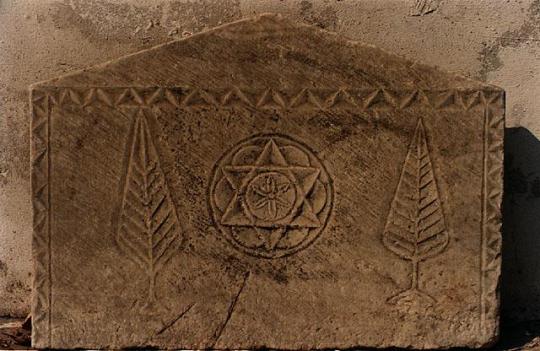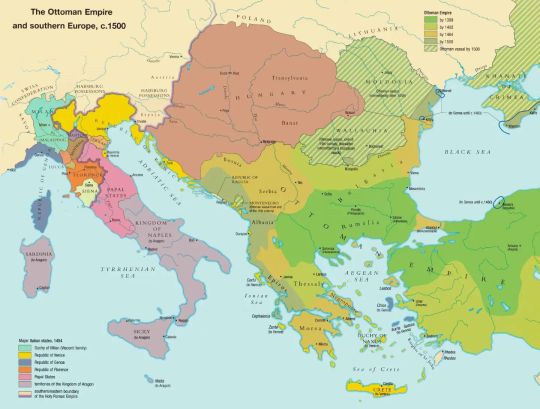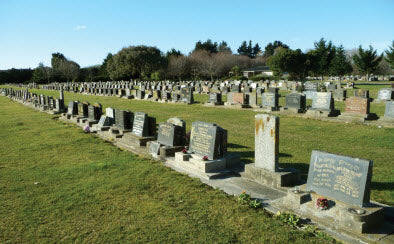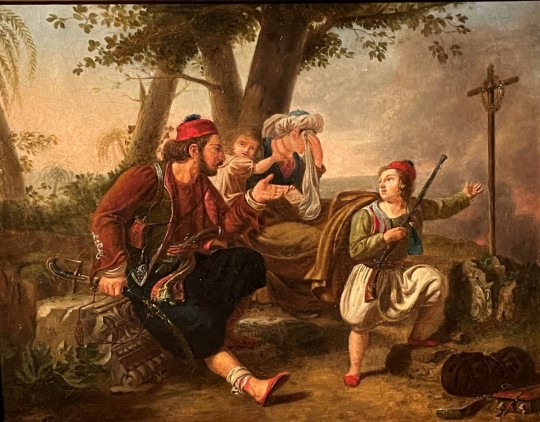#Chios Massacre
Photo

MWW Artwork of the Day (5/29/23)
Eugène Delacroix (French, 1798-1863)
The Massacre at Chios; Greek Families Awaiting Death or Slavery (1824)
Oil on canvas, 419 x 354 cm.
Musée du Louvre, Paris
A military attack on the inhabitants of Chios by Ottoman forces commenced on 11 April 1822 and was prosecuted for several months into the summer of the same year. The campaign resulted in the deaths of twenty thousand citizens, and the forced deportation into slavery of almost all the surviving seventy thousand inhabitants. Delacroix's painting shows some of the horror of the wartime destruction visited on the island in his "Massacre at Chios," in which a frieze-like display of suffering characters, military might, ornate and colorful costumes, terror, disease and death is shown in front of a scene of widespread desolation. Unusual for a painting of civil ruin during this period, "The Massacre at Chios" has no heroic figure to counterbalance the crushed victims, and there is little to suggest hope among the ruin and despair.
For a comprehensive look at this artist's work, check out this MWW gallery/album:
https://www.facebook.com/media/set/?set=a.741178099320895&type=3
13 notes
·
View notes
Text

Anamnistika
#john perivolaris#black and white#monochrome#greece#Anamnistika#leicaq2monochrom#summilux 28mm f1.7#walls#text#surfaces#charlie hebdo#aegean#chios#doorway#europe#handwriting#history#aegean islands#Isola#Massacre#mediterranean#Memento#memory#outdoor#Pirgi#popular culture#Time#decay#tragedy#traces
12 notes
·
View notes
Text

SCENES FROM THE MASSACRES OF CHIOS (1824) by EUGÈNE DELACROIX
In the foreground of DELACROIX'S canvas, we see a group of distraught GREEK men, women, and children laying huddled (some dead, some barely alive) on the ground.
On the left, a man expires from a stomach wound while his wife leans on his shoulder; on the right, a dead mother leans against an elderly woman as her child tries without success to suckle at her exposed breasts.
Behind them on the right an OTTOMAN TURK charges towards the group dragging a naked prisoner as a figure tries in vain to stop him with upraised hands. In the background, less defined figures are engaged in battle in the devastated landscape as the ocean meets the horizon line of a golden sky.
The painting was inspired by events from the 1822 GREEK WAR OF INDEPENDENCE, during which TURKISH OTTOMAN troops invaded the island of Chios and slaughtered thousands of rebelling GREEKS. DELACROIX diverged from the conventions of classical narrative painting in which order, regularity, and a sense of control prevailed. Rather, this work establishes a new approach to historical drama.
This work was not well received when exhibited at the PARIS SALON, as many critics felt it depicted the GREEKS as victims, rather than brave fighters, leading one to quip: "it's the Massacre of Painting." Others saw fault with its loose brushwork and declared the canvas "le laid" (the ugly).
#the Massacre at chios#eugene delacroix#romanticism#romantic art#romantic paintings#romantic artist#romantic
0 notes
Text


Old tombstones from the Jewish Cemetery in Chios on display in a museum, Greece, ca. 1980
According to Josephus, Yevanic-speaking Jews lived in Chios in ancient times, mostly as Roman slaves. After 1492, Sephardic exiles from Iberia ultimately became the Jewish majority group in Chios, mixing with the already prospered Romaniote, Italqi and Ashkenazi communities. Common occupations for Jews of the time were the making of silk garments, weaving, wine production, and olive and fig farming. They were also involved with the production of the islands' most valuable commodity, mastic. For many centuries, the Jewish life was thriving under the Ottoman Empire alongside, and in harmony with their Greek Christian and Turkish Muslim communities. Everything changed with the start of a chain of wars taking place in the region: the Greek War of Independence, the Ottoman Massacre of Chios, the First Balkan War, the Greco-Turkish War, and finally the Second World War, which effectively ended the long and rich Jewish history of the island.
414 notes
·
View notes
Photo

The aftermath of the fall of Constantinople in southern Europe
« Byzantium, bulwark of Christianity », R. M. Kean, Thalamus, 2006
by cartesdhistoire
The news of the fall of Constantinople was met with fear by all of Christendom. Constantinople was looted for the three days prescribed by Islamic custom: the locals were massacred—especially those who had gathered in Hagia Sophia—ransacked, or sold as slaves. Among the most prominent figures, Lucas Notaras and the Grand Domestic Andronicus Cantacuzenus were beheaded. Their families, along with many other prisoners, were sent to Edirne, becoming valuable currency for exchanges with the West.
Among those escaping Constantinople were several Palaiologoi, two Cantacuzenoi, two Komnenoi, two Laskarides, and many other members of prominent families. Some settled in Chios, where they first boarded a Genoese ship; others stopped at Monemvasia in Morea, Corfu, and Italy. The Genoese of Galata ransomed many Byzantines who went on to enlarge the ranks of the Greek diaspora in the islands, other Venetian possessions, and especially in Venice itself, which became the main city of the diaspora, as well as in Italy.
The Byzantines who escaped the massacre committed by the Turks following the city's capture organized into an autonomous commune in the Ottoman Empire, under the leadership of an elected leader. The Sultan appointed Gennadios Scholarios as Patriarch, due to his hostile stance on the Union of Orthodox and Catholic Churches. He was enthroned in January 1454 in the Church of the Holy Apostles (Hagia Sophia had already been reconsecrated as a mosque).
The Knights of Saint John confronted the Sultan's forces in 1480 and held out until 1520. The Morea, already ravaged by the antagonism of the Palaiologos brothers, fell in 1460. On August 15, 1461, David Komnenos, the last emperor of Trebizond, surrendered the last throne of the Byzantine world to the Sultan.
76 notes
·
View notes
Text






Friday, 4.26.24
Today I:
Did Yoga With Adriene
Did a 30-min. strength workout
Listened to ep. 11 of the Coffee Break French podcast
Listened to a bonus ep. of the ArtCurious podcast
Watched Julie Mehretu: Palimpsest (2006, free on ALL ARTS)
Read "Théodore Géricault, Portraits of the Insane"
Watched "Delacroix, Scene of the Massacre at Chios"
Watched "Delacroix, The Death of Sardanapalus"
Watched "Delacroix, Liberty Leading the People"
Went to a plant sale at my local botanical garden! Pics above!
Updated my finances
Caught up on YouTube subscriptions
Entered galley giveaways on Goodreads and Storygraph
Watched an ep. of Grey's Anatomy
Researched off-campus housing
Played The Sims 4
1 note
·
View note
Text

The Massacre at Chios
Eugène Delacroix • 1824 • oil on canvas • 419 x 354 cm • Musée du Louvre • Romanticism
1 note
·
View note
Text
Numerous artistic treasures from or inspired by Greece are housed in Paris museums.
From the forms of various types of Greek buildings—including temples, stoas, theaters, bouleuterions, houses, stadiums, gymnasiums, palestras, fountain houses, fortifications, and altars—numerous builders throughout Europe drew inspiration. The Greek architectural orders of Doric, Ionic, and Corinthian have certainly left a substantially visible impact on the entirety of Europe.
Apollo at Versailles
Alexander the Great at Versailles
The Treasure of Greek Arts at the Louvre Museum
The Winged Victory, or Nike of Samothrace
Aphrodite of Milos, or Venus de Milo
The Athena of Velletri, or Diana of Versailles
The Massacre at Chios, by Eugene Delacroix
Entry of the Crusaders in Constantinople, by Eugene Delacroix
1 note
·
View note
Photo

Eugène DELACROIX 1798 - 1863 “Young Orphan Girl in the Cemetery” Salon of 1824 under the title 'Study'. Oil on canvas Photo is taken by: @robertpuffjr Eugène Delacroix painted this around 1824 as preparatory work for his later work, The Massacre at Chios. The painting portrays the despair of a young girl, with a desolate cemetery in the background. (This writeup is taken from the description at the museum.) Louvre, Paris, France 🇫🇷 #historyofart #arthistory #greatworksofart #artmuseum #art #artist #masterpiece #painting #museumvisit #artlover #artists #artblogger #eugènedelacroix #delacroix #louvre (at Museo del Louvre) https://www.instagram.com/p/CnTSW7JrGtX/?igshid=NGJjMDIxMWI=
#historyofart#arthistory#greatworksofart#artmuseum#art#artist#masterpiece#painting#museumvisit#artlover#artists#artblogger#eugènedelacroix#delacroix#louvre
1 note
·
View note
Text
Mysterious and Supernatural Series: Violent Massacres
I’m always humbled by how cruel humans can be to other humans, gun laws are getting tighter here in Canada but are the government going after the right people? So many illegal guns cross the borders daily and end up in street crimes.
Some mass murders that we don’t want to think about but maybe we should remember.

Facts:
- largest mass murders with guns, December 29, 1890, hundreds of USA troops surrounded a Lakota camp and opened fire, killing more than 300 Lakota, women, men and children
- in the Philippines in 1639 a Chinese community of 17,000 - 22,000 people were slaughtered in a joint Filipino-Spanish (indigenous inhabitants).
- Chios massacre March - July 1822, Istanbul massacred 52,000 Greeks on the island of Chios during the Greek War of independence
- in 1933-1945, Hitler had 6 million Jewish people brutally murdered, an act of Ethnocide
- 1831 - 1996, cultural genocide the murders of countless native children in Canada’s Residential Schools
There’s been a ban on handguns in Canada
- yet in 2021 4/10 (41%) of homicides were firearm related
- firearm related violent crime typically represent less than 3% of police-reported violence in Canada
- recent estimates indicate that 26% of Canadian households own at least one firearm - August 2022
- Toronto Deputy Chief Myron Demkiw testified 86% of crimes involving guns, were guns that were smuggled into Canada (mostly from the US via USA/Canadian borders)
- banning gun owners to purchase or transfer firearms is not going to stop gun violence in Canada when over 80% of crimes involving firearms are illegal firearms, I’m not saying stop the ban, what I am saying is don’t just assume this is all going to just disappear.
in the News
10 of the worst mass murders in Canada | The Star
Most of the crime guns seized in Toronto are smuggled into Canada from U.S.: police | National Post
10 Most Brutal Massacres in History | RealClearHistory
‘Cultural genocide’: the shameful history of Canada’s residential schools – mapped | Indigenous child graves | The Guardian
R. J. Davies
A Riveting Jacked-In Dreamy Mind-Bender

Visit my website at https://rjdavies.ca/ and sign up for my mailing list!
#R. J. Davies#R. J. Davies Author#Rhonda Davies#Rhonda Joan Davies#Mystery author#science Fiction author#author of Maddox Files#mass murders
0 notes
Text

1822
#1822#Aegean#Anamnistika#Black and White#Memento Mori#Still Life#Chios#Church#Death#Europe#Bones#Ghosts#Massacre#Greece#History#Island#Isola#John Perivolaris#Leica Q2 Monochrom#Mediterranean#Memory#Monochrome#Monastery#Nea Moni#Ossuary#Skull#Sombre#Summilux 1:1.7 28mm ASPH#Time
10 notes
·
View notes
Text
Benaki Museum of Greek Culture Athens Greece
Benaki Museum of Greek Culture Athens Greece

View On WordPress
#1821#1821-2021 Initiative#200th anniversary of the Greek Revolution of 1821#Alexandra Benakis#Alexandros Mavrokordatos#Ali Pasha and Kyra Vassiliki#Amy Scheffer Young Greek Defending Wounded Father 19th c.#and Stéphan Adler#Angelos Akotantos St. Anne and the Virgin 15th Century#Antonis Benakis#Apostolos Argyriadis#Argini Benakis#Asia Minor Catastrophe#Benaki Museum of Greek Culture#Benakis Family#Bouboulina Nafplion Greece Velvet with Silk Pattern 20th c.#Chios Massacre#Christos Bokoros 1821#Collectors Choice Exhibition – 1821 Before and After the Greek War of Independence#Constantinople and Venetian Domination of the island of Crete#Cretan Renaissance#Delacroix Scenes from Massacres at Chios 1825#Dionisios Taskos An Islander Zakynthos#Emmanuel Benakis#Era of Eleftherios Venizelos Greek Prime Minister#Ethnos Greek Newspaper#First Greek Constitution#Georgios Nomikos 1680 Lady of the Angels#Greco-Turkish War#Greek Icons 15th-7th c.
0 notes
Photo

Eugene Delacroix - Scenes from the Massacre of Chios (#OilOnCanvas 1822) #Orientalism #Orientalismo #Eugene #Delacroix #EugeneDelacroix #Massacre #Chios #Kunst #Konst #Művészet #Fan #Āto #искусство #Arte #Art #ArteVersoMarte #Massacro #OlioSuTela https://www.instagram.com/p/B8O18wTq_kJ/?igshid=vc2r6jz3sivf
#oiloncanvas#orientalism#orientalismo#eugene#delacroix#eugenedelacroix#massacre#chios#kunst#konst#művészet#fan#āto#искусство#arte#art#arteversomarte#massacro#oliosutela
0 notes
Photo


Photo of Konstantinos Kanaris 1877
Konstantinos Kanaris, (Greek: Κωνσταντίνος Κανάρης; c. 1790 – 2 September 1877), was a Greek admiral, Prime Minister, and a hero of the Greek War of Independence.
After the beginning of the Greek revolution in 1821 the island of Psara formed its own fleet and the famed seamen, already known for their well-equipped ships and successful combats against sea pirates, proved to be highly effective in naval warfare. Kanaris soon distinguished himself as a fire ship captain.
At Chios, on the moonless night of 6–7 June 1822 forces under his command destroyed the flagship of the Ottoman admiral Nasuhzade Ali Pasha in revenge for the Chios massacre. The Turkish casualties comprised 2,300 men, both naval officers and common sailors, as well as Nasuhzade Ali Pasha himself.

Kanaris led another successful attack against the Ottoman fleet at Tenedos in November 1822. He was famously said to have encouraged himself by murmuring "Konstantí, you are going to die" every time he was approaching a Turkish warship on the fire boat he was about to detonate.
#he was a great and brave man#Konstantinos Kanaris#most of his family got killed by turks too#1821#heroes of 1821#greek people#greek history
52 notes
·
View notes
Text
Paintings inspired by the Greek Revolution of 1821 and the Greek War of Independence (I)

The Oath of the Filiki Etaireia, the secret organization which prepared the Greek Revolution of 1821. A painting by Dionysios Tsokos, 1849.

Theodoros Vryzakis The Bishop of Old Patras Germanos Blesses the Flag of Revolution, 1865. The blessing of the flag by Germanos at the monastery of Agia Lavra in the NW Peloponnese is the event which has been traditionally accepted as marking the beginning of the Greek Revolution of 1821 on March 25, 1821 (old calendar). However, the truth is that the Revolution had started in other places weeks before March 25 and some historians even doubt the historicity of the traditional narrative about the blessing of the flag at Agia Lavra. It remains that March 25 has been fixed as the date of the celebration of the Greek Revolution since the 1830′s, as it combined the idea of the rebirth of the nation with the major religious feast of the Annunciation (and flattered the clergy and the Peloponneseans).

Theodoros Kolokotronis (1770-1843), the greatest military figure of the Greek Revolution and War of Independence, here as painted by Dionysios Tsokos.

Laskarina Bouboulina, Greek naval commander and heroine of the Greek War of Independence (Oil painting, the National Historical Museum, Athens ).

“First National Assembly” by Ludwig Michael von Schwanthaler. In the beginning of 1822 the First National Assembly of the Greeks adopted by vote at Epidaurus the provisional first Constitution of the independent Greece, a text influenced by the principles and constitutional texts of the American and French Revolutions.

The Battle of Dervenakia (July 1822), a major Greek victory under Theodoros Kolokotronis, having as result the destruction of the Ottoman army which had invaded the Peloponnese. Painting by Theodoros Vryzakis, 1860.

Eugène Delacroix The Massacre at Chios, 1824, work having as theme the massacre of the Greek population of the island of Chios by the Ottomans in 1822.

The burning of the Turkish flagship by Kanaris. Painting by Nikiforos Lytras, c. 1873. As revenge for the massacre of the Greeks of Chios, a Greek fireship under Konstantinos Kanaris from the island of Psara burnt on 18 June 1822 off Chios the Ottoman flagship, killing almost two thousand Ottoman officers, sailors and soldiers, among them the Kapetan Pacha (Ottoman Grand Admiral) Nashuhzade Ali (known to the Greeks as Kara Ali), the main responsible for the massacre.
3 notes
·
View notes
